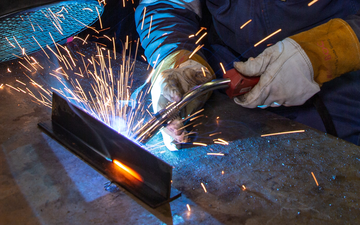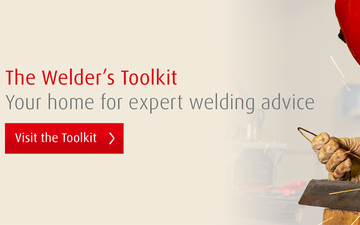- Official BOC UK Online | Industrial Gases | Products & Solutions | BOConline UK
-
Shop
- Industries
- Processes
- Gases & Equipment
-
Solutions
-
Services
-
Health & Safety
-
Contact & Support
- What's Happening
-
Net Zero Strategies
Torch Technique: Eight Tips for MIG Welding Magic
Posted by BOC

Whether welding is your hobby or you’re keen to brush up on your skills, here are eight useful tips for choosing, preparing and wielding your MIG welding equipment.
1. Safety first
Personal Protective Equipment (PPE) is paramount. You’ll need:
- Safety Boots – with reinforced steel toe caps, fire retardancy and cushioning for comfort.
- Overalls/gloves – overalls must fit well and be cut from approved flame-retardant material. Welding gloves / gauntlets should be leather with a snug fit, but flexible for some movement.
- Helmet / Visor – invest in the best protection for your face and head. This means equipment approved to EN175 and E379 standards, with adjustable lens darkness to suit the type of weld you are performing. Also recommended is a ventilated unit, such as a powered air-purifying respirator (PAPR) system, which delivers filtered air via an air hose into a head mounted welding visor. You should always ensure your workshop is well-ventilated or has active fume extraction. Use Local Exhaust Ventilation (LEV) where possible. Your welding posture is important – don’t lean directly over the welding fumes given off from the welding arc. It’s also vital to wear flame-retardant head protection beneath your helmet.
2. Choose wisely
Ensure you’ve selected the right wire type and diameter to suit your metal type and thickness, otherwise the weld metal will not transfer efficiently, and you’ll run the risk of a weak or poor quality weld. Rule of thumb is:
- For mild steel thickness of 1mm to 1.6mm, use a 0.8mm wire
- For mild steel thicknesses between 1.6mm to 6mm choose a 1mm wire
- For mild steel thickness greater than 10mm mild steel needs a 1.2mm wire
Get used to your torch, too. There’s no harm in practising how to handle it – modifying your stance – so you’re comfortable with its weight and position.
3. Believe your eyes
Each time you prepare to weld, remember to inspect your equipment first. This means ensuring your torch neck is tight, the wire feeder connection is secure, and the trigger is operating smoothly.
Beyond this, relying on common sense and your own inspection are critical. If your eyes tell you something looks damaged, don’t use your torch – faulty equipment can cause an electric shock. Finally, make sure you connect your work return lead (sometimes referred to as earth clamp) securely to ensure an effective connection and maximise safety.
An annual gas equipment safety check is vital to ensure your equipment is in good working order and safe.
4. Perfect position
The welding torch cable/umbilical positioning and wire tension are crucial for a job well done. They help you avoid too much tension in the wire, causing deformities that can reduce speed and weld quality.
Meanwhile, wire stick out – the amount of wire visible from the end of the shroud – is best at around 10 x the wire diameter to show the weld being deposited, while also preventing a reduction in shielding gas effectiveness.
5. Right angles
Being comfortable and standing steady while welding is vital. The last thing you want if you’re learning about welding is for it to become a pain in the neck.
Be happy with your posture and balance, and have a clear view of where you’re depositing the weld. The ideal torch position is 90° to the joint to ensure penetration, while leaning back around 10-15°.
6. Keep pace
Avoid going too quickly or slowly with your weld. Faster speeds can make welds brittle; slower rates overheat the metal. Correct travel speed should keep your weld to the leading third of the puddle and prevent deposition of too much or too little material.
Also keep an eye on the weld deposit throughout to evaluate additional aspects such as correct width, undercut and spatter avoidance.
7. Don’t sweat beads
Over time, the more you practise, the more you’ll improve at spotting a good weld deposit compared with a bad weld deposit.
Signs a weld has gone well include: uniformity of width; evenly layered ripples; good weld penetration; and lack of gas pockets, cracks, porosity and arc strike marks.
8. Clean with care
Look after your tools and they’ll look after you. A good weld relies on high-quality consumables and a clean metal surface, so it’s essential to ensure your torch is clean and damage-free after you’re done for the day.
A regular routine of cleaning, checking and storing torches can extend their lifespan, saving time and money in the long run.
Ready for a new torch? Check out our full range of air-cooled and liquid-cooled MIG torches and accessories on our website.
For more practical welding tips, check out the Welder’s Toolkit, the home of expert welding advice.

